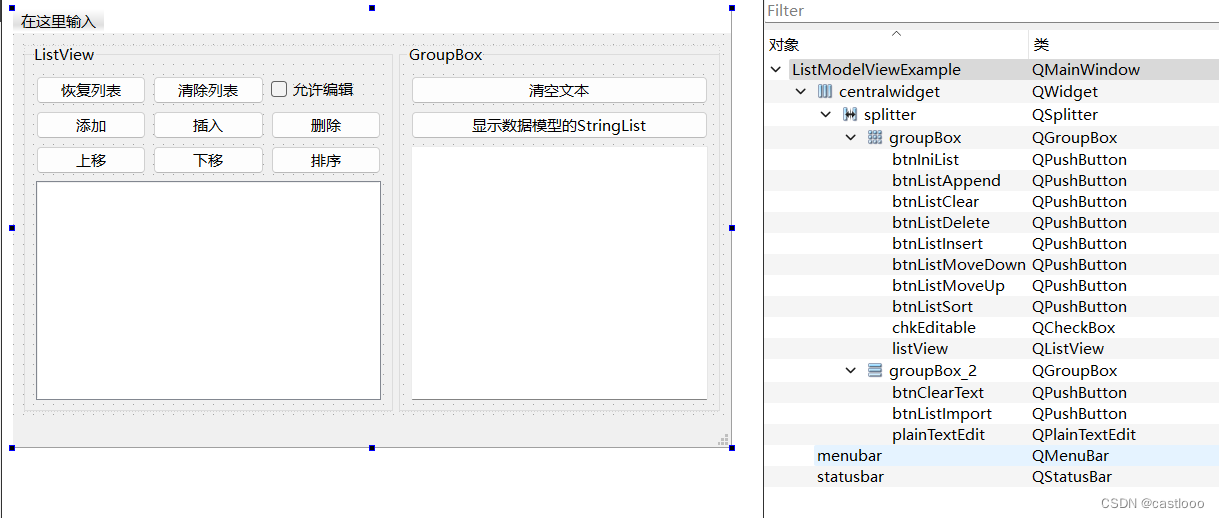1.QStringListModel 绑定到listView,从而实现MV模型视图
2.通过QStringListModel的新增、删除、插入、上下移动,listView来展示出来
3.下移动一行,传入curRow+2 的个人理解
布局

.h声明
private: QStringList m_strList; QStringListModel *m_model;
.cpp
#include "listmodelviewexample.h"
#include "ui_listmodelviewexample.h"
ListModelViewExample::ListModelViewExample(QWidget *parent)
: QMainWindow(parent)
, ui(new Ui::ListModelViewExample)
{
ui->setupUi(this);
m_strList<<"北京"<<"上海"<<"广州"<<"深圳"<<"天津"<<"成都"<<"山东"<<"河南"<<"河北";
m_model= new QStringListModel(this);
m_model->setStringList(m_strList);
ui->listView->setModel(m_model);
ui->chkEditable->setChecked(true);
ui->listView->setEditTriggers(QAbstractItemView::DoubleClicked|
QAbstractItemView::SelectedClicked);
}
ListModelViewExample::~ListModelViewExample()
{
delete ui;
}
void ListModelViewExample::on_btnIniList_clicked()
{
m_model->setStringList(m_strList);//重新载入
}
void ListModelViewExample::on_btnListClear_clicked()
{
m_model->removeRows(0,m_model->rowCount());
}
void ListModelViewExample::on_chkEditable_clicked(bool checked)
{
if(checked)
ui->listView->setEditTriggers(QAbstractItemView::DoubleClicked
|QAbstractItemView::SelectedClicked);
else
ui->listView->setEditTriggers(QAbstractItemView::NoEditTriggers);
}
void ListModelViewExample::on_btnListAppend_clicked()
{
m_model->insertRow(m_model->rowCount());
QModelIndex index= m_model->index(m_model->rowCount()-1,0);
m_model->setData(index,"new Item",Qt::DisplayRole);
ui->listView->setCurrentIndex(index);
}
void ListModelViewExample::on_btnListInsert_clicked()
{
QModelIndex index= ui->listView->currentIndex();
m_model->insertRow(index.row());
m_model->setData(index,Qt::AlignRight,Qt::TextAlignmentRole);
ui->listView->setCurrentIndex(index);
}
void ListModelViewExample::on_btnListDelete_clicked()
{
QModelIndex index= ui->listView->currentIndex();
m_model->removeRow(index.row());
}
void ListModelViewExample::on_btnListMoveUp_clicked()
{
int curRow = ui->listView->currentIndex().row();
QModelIndex index = QModelIndex();
/*
moveRow这个方法,为什么要-1? 我理解如下,
1. 在目标位置curRow-1插入一行 插入的新行的行号为curRow-2
2. 复制原curRow行到目标位置curRow-2
3. 删除原curRow行
*/
m_model->moveRow(index,curRow,index,curRow-1);
}
void ListModelViewExample::on_btnListMoveDown_clicked()
{
int curRow = ui->listView->currentIndex().row();
QModelIndex index = QModelIndex();
/*
moveRow这个方法,为什么要+2? 我理解如下,
1. 在目标位置curRow+2插入一行
2. 复制curRow行到目标位置curRow+1
3. 删除curRow行
*/
m_model->moveRow(index,curRow,index,curRow+2);
}
void ListModelViewExample::on_btnClearText_clicked()
{
ui->plainTextEdit->clear();
}
void ListModelViewExample::on_btnListImport_clicked()
{
QStringList tmpList = m_model->stringList();
for(int i=0;i<tmpList.size();i++)
{
ui->plainTextEdit->appendPlainText(tmpList.at(i));
}
}
void ListModelViewExample::on_btnListSort_clicked(bool checked)
{
if(checked)
m_model->sort(0,Qt::AscendingOrder);
else
m_model->sort(0,Qt::DescendingOrder);
}
void ListModelViewExample::on_listView_clicked(const QModelIndex &index)
{
QString str1 = QString::asprintf("模型索引行号:row=%d,column=%d;\t",
index.row(),index.column());
QVariant var = m_model->data(index,Qt::DisplayRole);
QString str2 = var.toString();
int curRow = ui->listView->currentIndex().row();
QString str3 = QString::asprintf(";\tlistView:row=%d",
curRow);
ui->statusbar->showMessage(str1+ str2+ str3);
}
QStringListModel->moveRow 上移传入curRow-1 下移传入curRow+2 这是为什么?有些别扭
inline bool QAbstractItemModel::moveRow(const QModelIndex &sourceParent, int sourceRow,
const QModelIndex &destinationParent, int destinationChild)以下仅为个人理解。
destinationChild:创建了一个新行,该新行需要插入的位置,插入新行后,原行删除。
如下移一行,就需要在curRow+2的前面插入一行,插入的新行的行号为curRow+2,删除原行后变成curRow+1
再如上移一行,需要在curRow-1的前面插入一行,插入的新行号变成了curRow-1,而原curRow-1变成了curRow行号






















 1万+
1万+











 被折叠的 条评论
为什么被折叠?
被折叠的 条评论
为什么被折叠?








